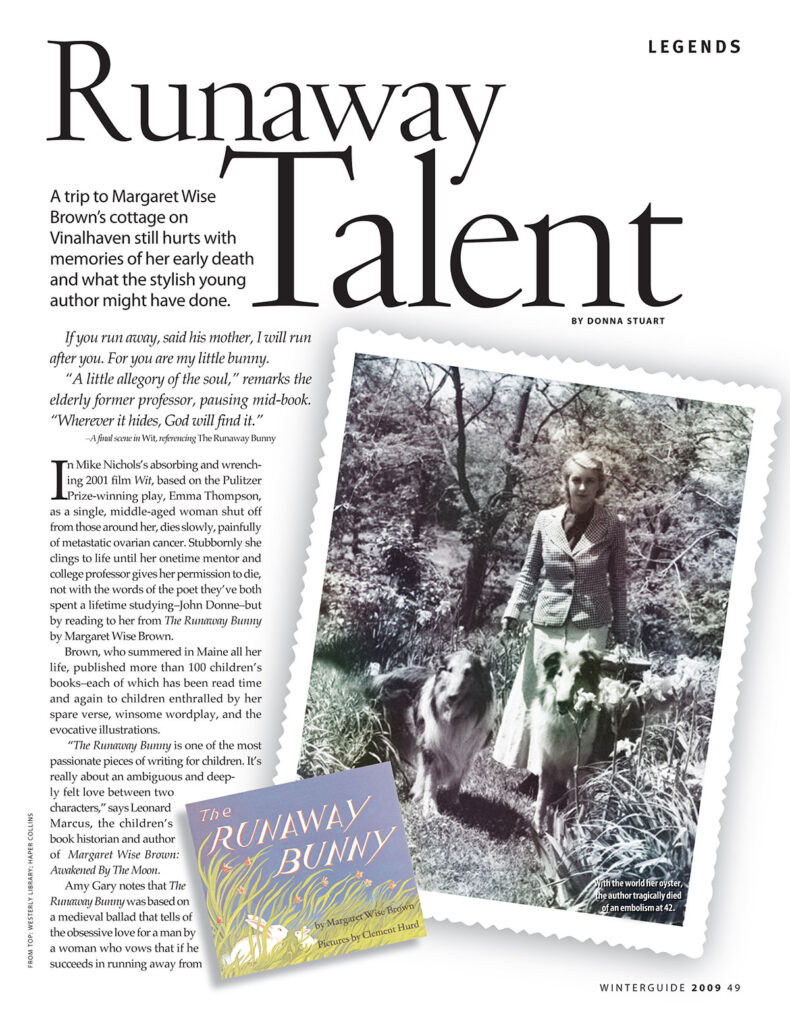A trip to Margaret Wise Brown’s cottage on Vinalhaven still hurts with memories of her early death and what the stylish young author might have done.
By Donna Stuart
If you run away, said his mother, I will run after you. For you are my little bunny.
“A little allegory of the soul,” remarks the elderly former professor, pausing mid-book.
“Wherever it hides, God will find it.” –A final scene in Wit, referencing The Runaway Bunny
In Mike Nichols’s absorbing and wrenching 2001 film Wit, based on the Pulitzer Prize-winning play, Emma Thompson, as a single, middle-aged woman shut off from those around her, dies slowly, painfully of metastatic ovarian cancer. Stubbornly she clings to life until her onetime mentor and college professor gives her permission to die, not with the words of the poet they’ve both spent a lifetime studying–John Donne–but by reading to her from The Runaway Bunny by Margaret Wise Brown.
Brown, who summered in Maine all her life, published more than 100 children’s books–each of which has been read time and again to children enthralled by her spare verse, winsome wordplay, and the evocative illustrations.
“The Runaway Bunny is one of the most passionate pieces of writing for children. It’s really about an ambiguous and deeply felt love between two characters,” says Leonard Marcus, the children’s book historian and author of Margaret Wise Brown: Awakened By The Moon.
Amy Gary notes that The Runaway Bunny was based on a medieval ballad that tells of the obsessive love for a man by a woman who vows that if he succeeds in running away from her, she’ll be the flowers on his grave. Gary, who edits and manages the rights to Brown’s unpublished work, discovered a treasure trove of stories locked away in a trunk in Brown’s sister’s barn attic in Vermont in 1990. Since then, she’s published more than a dozen new books by Brown; the most recent of which is The Moon Shines Down. “So many people in the industry call Brown ‘the guru of children’s publishing,’” says Gary. “She had the ability to understand the emotional context and the stages children must go through to become adults,” even though she never had children of her own.
The only home Margaret Wise Brown ever owned was “The Only House,” an abandoned quarrymaster’s cottage on Vinalhaven she bought in 1943. There she wrote, daydreamed, entertained friends, and lived the island life, as dictated by the season and the sea. “I’ll meet you at the black buoy,” she’d tell friends who’d make the trek to Rockland, then catch a boat ride with obliging islanders. A white cast-iron rabbit greeted visitors by the door. From the living- room windows, they could see the rocky, treed outcropping Margaret wrote about in The Little Island.
Like Thompson’s character in Wit, Brown died relatively young. In 1952 at just 42, while recovering after surgery, she kicked her foot over her head cancan style to prove how well she was feeling. Heartbeats later, she was dead of an embolism. Her ashes were scattered not far from her tree at the edge of the universe, looking over the water. The rough stone marking the spot is inscribed, “Margaret Wise Brown, writer of Songs and Nonsense.”






0 Comments